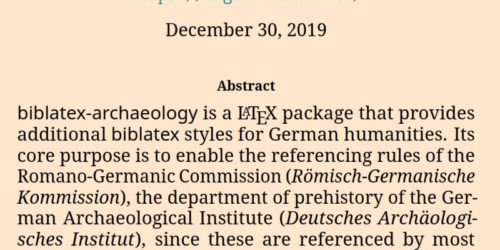Good news! Yesterday version 2.2 of my LaTeΧ package biblatex-archaeology was released, with which it comes close to feature completeness. There are no new features on my to-do list, only some minor improvements of existing features and better documentation. Unfortunately there was a huge delay in upgrading, and since the release of biblatex 3.14 biblatex-archaeology stopped working at all. I am very sorry for that. But as it is feature complete now, this situation should not rise again. There will be no lengthy development periods anymore (fingers crossed!).
The RGK guidelines has been slightly changed. The styles rgk-inline, rgk-numeric and rgk-verbose were updated. The old behaviour is restored in rgk-inline-old, rgk-numeric-old and rgk-verbose-old, bringing the number of available end user styles up to 35. See sample PDFs on the project page!
There are several new cite commands. \citeissue and friends allow for quoting journals like this Ber. RGK 69, 1988
. This works only in conjunction with entry type @periodical, otherwise they issue an error. \reviewcite and friends are somewhat reduced \fullcite commands that some journals need for reviews where bibliographies are not allowed
Entry type @review is now capable of generating its title from a list of keys in its related field. This turned out to be a complex task which needed a couple of commands to direct it properly if the settings of the preformatted styles are not sufficient.
Sorry for the self-praise but I believe it will not be possible to drive automated archaeological citation and bibliography far beyond without beginning coding from scratch. I made some tests converting the sample document (which aims to collect difficult cases for debugging purposes) into LibreOffice’ *.odt files which can get read by MS Word and similar text processors. The results are far better than expected. I am pretty sure that papers with a lot of references are better written in LaTeΧ with biblatex-archaeology and then converted by tex4ht than written in *.docx from scratch. I am going to demonstrate this in a separate blog post.


Leave a Reply